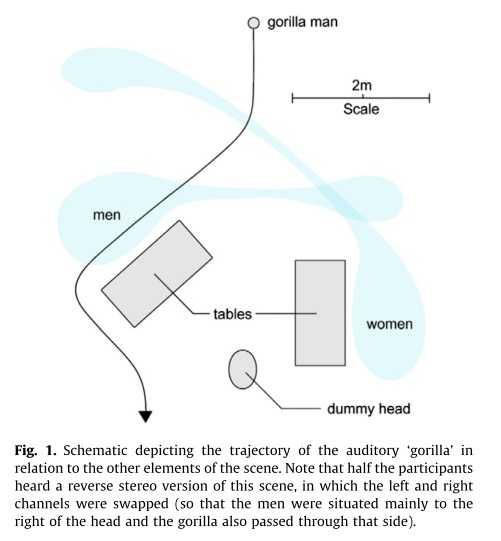Tagged: Fraenkel_N
Gorillas we have missed: Sustained inattentional deafness for dynamic events.
Dalton, P., & Fraenkel, N. (2012). Gorillas we have missed: Sustained inattentional deafness for dynamic events. Cognition, 124(3), 367-372.
The ability of selective attention is a crucial ability that allows us – and only that way – to behave effectively in a world full of simultaneous stimuli.
Following the inattentional blindness paradigm, the authors focused on hearing,since it is considered an early warning system, tuned to detect unexpected stimuli. Is it rightly tuned?
In order to replicate the effect in hearing, Dalton and Fraenkel dissecated the inattentional blindness paradigm into three components:
1. A task relevant stimuli
2. A task irrelevant stimuli
3. An unexpected critical stimulus
This last ingredient should be similar to the irrelevant stimuli only in the dimension that differed them both from the relevant stimuli. However, they should differ from each other in other dimensions such as spatial location, speed, trajectory, shape, etc.
Having said this, the intriguing thing of the inattentional deafness effect is that “the similarity between the unexpected critical stimulus and the irrelevant stimuli on the dimension upon which relevant and irrelevant are defined, can prevent the detection of the critical stimulus, despite its salience on a number of other dimensions” (note to self -> is this somewhat molded by expectations? Are we tuned to expect some things based on experience (we are!), and does this speed up processing? Expectations as a tool to process the world faster.)
This doesn’t seem very efficient, because in real world situations, processing new and unexpected stimuli – fire alarms, unexpected movements – is likely to be more important than processing of continually present yet task irrelevant scene elements.
The twist on this experiment was that the authors used binaural sound to provide a realistic audio scene and the critical stimuli was dynamic. When thinking about the dichotic listening task, this set up makes spatial separation harder.
So, two men and two women were separately placed in a room, preparing a party. The dummy head was placed between these two tables. A man saying “I am a gorilla” passed near the men.This was the critical stimulus and it lasted for 19s.
In both experiments, the channels were reversed for half of the participants in order to balance for potential orientation effects.
In experiment 1, the gorilla passed near the men. Results showed that 90% of the participants attending to men’s conversation mentioned the gorilla. However, only 30% of the participants attending to the women’s conversation mentions the gorilla.
In experiment 2, the gorilla was presented in “mirror image”, such that it appeared on the other side of the screen, passing near the women. This was somewhat more flagrant than experiment 1 in the sense that the critical stimulus was near the relevant stimulus, and was different at least in the voice tone.
This time, 65% of the participants listening to men mentioned the gorilla, while only 45% listening to women mentioned it.
The results showed relevant evidence for the inattentional deafness effect with dynamic stimulus in 3D audio scenes. This finding can have serious implications in road safety.
Hopefully, more on that later.
